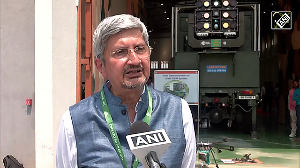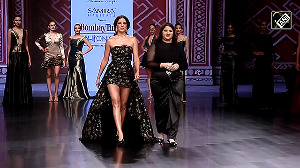"My father would say if they call you kaali, remember Kali was a goddess, who was very powerful. Be that goddess."
"Don't take it as a gaali (abuse), take it as a compliment."

When Roselynn Raj chose a career of modelling, she wanted to challenge the status quo and represent women with darker skin tones, relaying the message of body positivity.
The 32-year-old former journalist, who has a degree in law, hails from a highly-educated South Indian family of lawyers, and harboured the dream of becoming a model but kept it hidden from her parents for a long time.
Despite her tall aspirations, the attractive Ahmedabad-based model was not sure if the fashion industry was ready to accept someone like her.
In an interview with Rediff.com's Mayur Sanap, she talks about her journey and how she navigated her way in the profession to find success.
How do you describe yourself as a person?
I'm very curious. I love getting to know about things, not just specific to fashion, but also about the world, environment, geography and everything else.
Tell me about your family.
I come from a South Indian family. Both my parents are lawyers. Dad works for the Gujarat High Court.
When did you decide on becoming a model?
I think I was six or seven, basically in my third grade, when I first saw the Miss Universe pageant.
I wanted to be that woman standing there, basking in that spotlight, unbothered about what the world thinks of her. (Every Miss Universe) is strong, confident and very presentable. I like that about the winners.
I told myself I'd love to be a part of the industry and become a model.

How did your parents react when you told them about your modelling aspirations?
My parents attached more importance to education. So, I would secretly model for college students and design students. That was my little secret.
I lived two lives. One as a journalist (she worked with the Times of India and Indian Express). I've also done some advertising. That was my reality for my parents.
But in the background, I was also modelling. I did, in fact, tell them about my modelling after a Levi's campaign with Deepika Padukone (above, Roselynn is on the right).
They were shocked, yet happy, that I'm not in the wrong field. The fashion industry is often misunderstood among common people. They think there's a casting couch out there, and a lot of bad things can happen.
When my parents got to know that there's a whole lot of work that actually happens, and people do put in a lot of effort, they did appreciate it.
How did you start your modelling journey?
I came to Bombay during the Indian selection process for the Miss Universe pageant. I was selected for the regional round from Ahmedabad.
But I realised that it wasn't meant for me. I wasn't represented properly. My skin color wasn't welcome yet.
At that time, there was an agency called Feat Artists that was just starting up. They told me that they loved my skin colour and want me to be part of the agency.
In one year, I had already done editorials, and Feat Artists became the top agency in the country. We it made that happen. We loved fashion and wanted to represent it in our own way. And we did it.

Were you conscious of your skin colour, especially when you began as a model?
I was made to feel conscious. I was always bullied for my colour.
I grew up in Gujarat and they didn't know that South Indians have darker skin tones. Even as a child, I was bullied. When I walked on the road, I'd hear random comments like "kaali ja rahi hain."
But my parents were very supportive. They always would tell me that I am beautiful. Of course, in your parent's eyes, you're always beautiful. And that gave me strength.
I realised that I don't have to be beautiful. I don't have to be something else in order to be liked by others.
I thought let me just be myself and enjoy what I like.
How did the modelling industry welcome you?
In the beginning, they did not welcome me. I'm not a very tall model, and I am dark. Also, I don't have the perfect, pretty face.
But then all I did was work on my craft. Whenever I was in front of the camera, I wanted to give it my best shot.
I didn't have the body of a tall model, so I had to make my face stand out for the pictures to be very impactful.

There's a general perception that modelling is a no-intelligence-required job. How did you navigate through that notion?
When I came into the industry, I was not like a young teenager who did not know about the world. For instance, in my first contract, I did not just sign on a piece of paper. I changed the contract based on my terms and conditions because I'm also a lawyer.
Also, I mainly came into the industry for a lot of young dark girls to feel confident in their skin.
My parents were educated enough to understand what was happening and to guide me. But a lot of these young girls do not have that kind of support. I wanted these girls to believe that a dark-skinned girl can be as confident, as fashionable and as strong as any other model.
I wanted to walk up to these girls and say, "Hey, we are all equal. That's why god made us all and we can't be the same."
When I did a campaign for Shaya, a silver jewellery brand by Tata, there were so many girls who commented that now they can buy the jewellery because they know what it looks like on a dark-skinned person.
As a kid, I saw fair models wearing clothes and I would end up picking those colours, but they never suited me. I was always buying the wrong things.
Now I am representing those girls who didn't feel confident about their skin.
Who do you look up to the most in your life?
My father. I also share his skin colour.
As a young child when people would bully me, I would run to him. My mother is very fair, so she wouldn't understand what I was going through. But my dad would.
I would go and tell him, 'They call me kaali'.
He would tell me that 'If they call you kaali, remember Kali was a goddess, who was very powerful. Be that goddess. Don't take it as a gaali (abuse), take it as a compliment'.

Did you go through any bitter experiences in the industry because of your skin colour?
Not bitter, because I was already involved with Feat Artists.There was a certain respect because we were trying to change how models have to be represented.
For the first time, I could show off my actual colour skin colour. Otherwise, make-up artists would make it five shades brighter.
I never enjoyed modelling then. Brands were not ready to cast me for the first two years, because they did not know if it would work with their audience. This is purely business I would say. It was not personal.
The moment they saw dark-skinned models also doing fabulous work, they diversified. Today every kind of model is inclusive. We have so many different models -- plus-size, transgender, gay, etc. Every person is a buyer, right? So, everybody has to be represented.
Changes you'd like to see in the modelling industry.
I would love to see more diversity.
Clothes should be made for petite models as well. Right now, it's mostly made for tall models and then cropped to fit short models.
It will be nice to see more clothing for plus-size models. Not everyone is a model when you're selling your outfits. So, if you're making clothes, why not make them in all sizes? That's why we're in the business of fashion, right? To make a person look and feel confident and beautiful.












 © 2025
© 2025